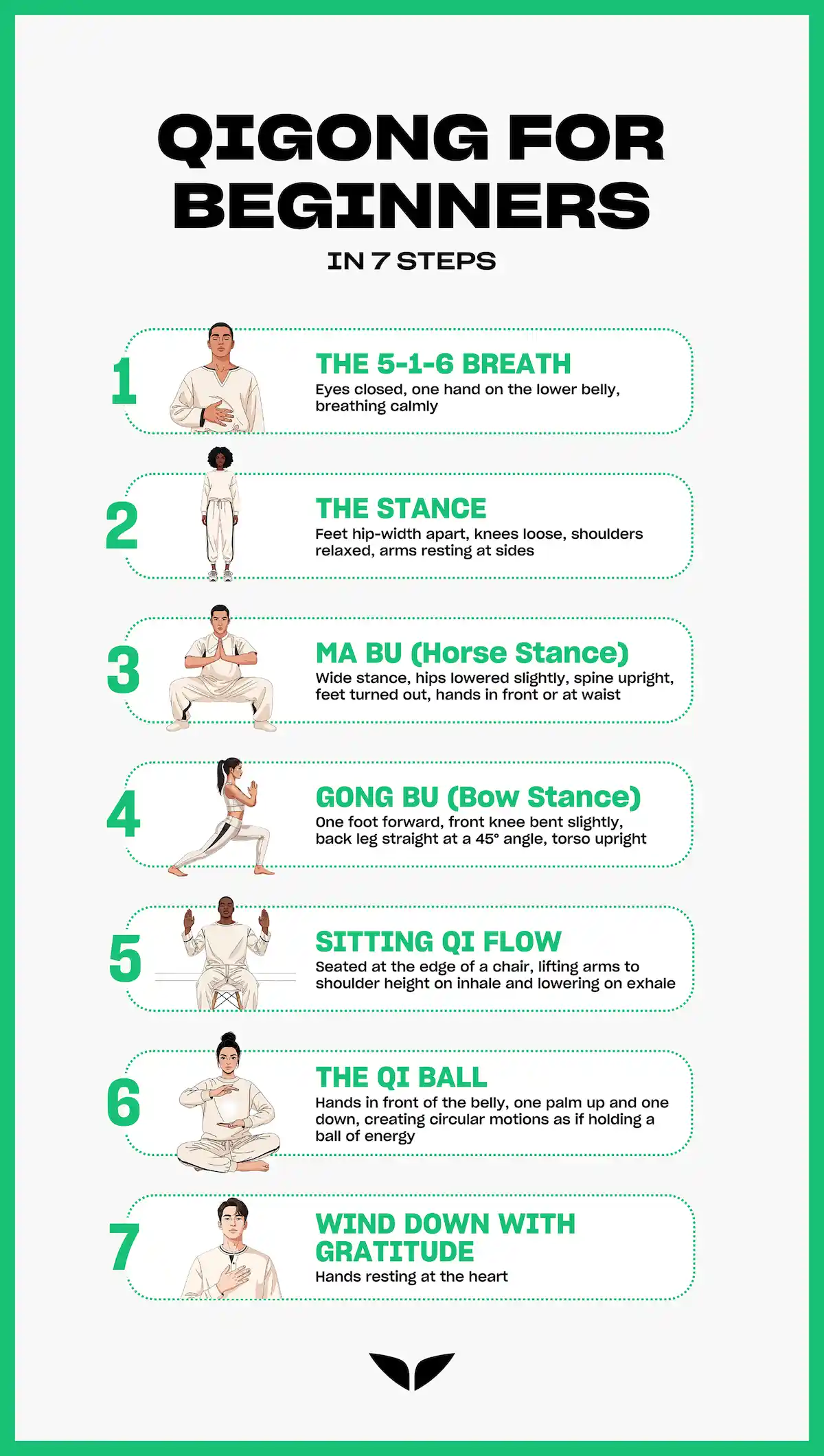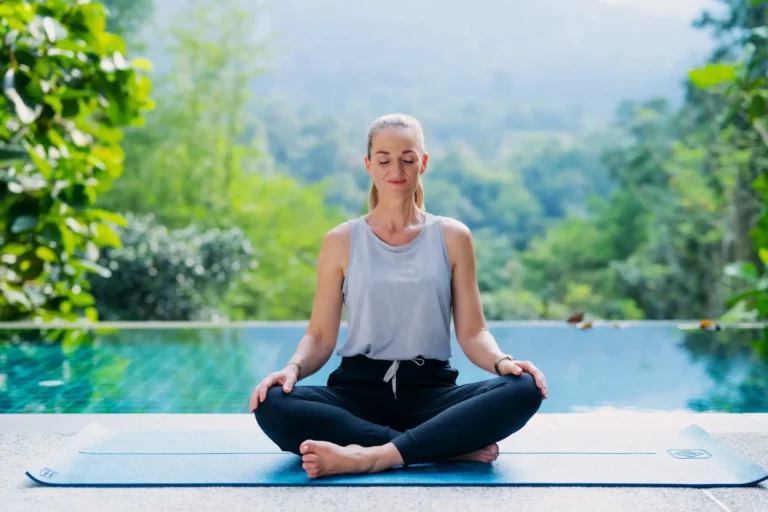Qigong for beginners. The phrase may catch your eye as you walk past a wellness studio. And something about it makes you linger for a moment longer than usual.
Maybe you’ve heard how this ancient Chinese practice calms so many people on social media. Perhaps you’ve walked past the nearest park and seen the elderly crowd starting their day there, moving their hands as if manipulating the air. Or maybe your best friend is raving about how it lowered their stress levels.
The interesting thing is, your curiosity brought you here. And it may be the first sign that you’re ready to see its wonders for yourself.
What is qigong?
The word qi (pronounced like the “chee” in lychee) refers to the life force that powers everything, including your body. Meanwhile, gong means skill. So together, they form qigong, which describes the skill of working with your life force.
Ask Lee Holden, a qigong, meditation, and tai chi expert, for his definition of it, and he’ll offer the simplest one. Qi, he says in Modern Qigong, his Mindvalley program, “simply means energy.” And it’s central to every movement and breath within the practice.
Qigong practice is a moving meditation. When you harmonize your own body’s energy, healing happens.
— Lee Holden, trainer of Modern Qigong on Mindvalley
From there, it helps to understand how this energy actually moves in your body. Traditional Chinese medicine teaches that qi moves through energy pathways called meridians. When they flow well, the body functions with more ease. But when they stagnate, usually from long hours of sitting or emotional strain, tension often arises.
Which is why picking up qigong exercises for beginners can be so grounding and can support your self-healing journey. They’re part of a Chinese energy healing system that uses specific breathwork techniques and body movements to improve your health and well-being.
“Qigong practice is a moving meditation,” says Lee. “When you harmonize your own body’s energy, healing happens.”
Benefits of qigong for beginners
One of the first things you’d notice about qigong is how quickly your body responds to it. The movements are simple, the breathing feels natural, and there’s an unmatchable feeling of something settling inside you.
Research on the benefits of slow, mindful movements—a signature of qigong—shows that their meditative effect can significantly calm the nervous system and lower your stress levels. This contributes to emotional balance. What’s more, regular practice paired with breathwork reduces inflammation, further improving physical function, reducing pain, and increasing mobility.
Now, these impacts are even more evident when you listen to those who tried it for the first time. Mindvalley members who have gone through Lee’s program, for one, have described fundamental, embodied change in their lives.
1. Body-to-soul synergy
Hayley Attwell, the British actress known for playing Peggy Carter in Captain America: The First Avenger, turned to qigong during a fast-moving season of work and travel. She wanted something that could steady her quickly without adding to the noise.
She describes Lee’s approach as “the perfect tool to help refocus and energize the mind, body, and spirit.”
The simple movements have since become her go-to tools for stepping out of her day and dropping back into her natural rhythm more easily, no matter where she is.
2. Better energy flow from day one
Erik Nordstrom, a musician from Phoenix, came in without expectations. He simply wanted a way to work with his personal energy.
After the first lesson, something shifted in a way he did not expect. “I was absolutely shocked at the effect it had after the first day,” he shares. He describes an intense, visceral feeling of energy moving through his body, along with a clear lift in his overall sense of well-being.
The experience left him energized enough to recommend others try it for themselves.
3. Quick exercises for a daily energy boost
For Katharyn Humble, a stylist from Ottawa, the goal was simple: relief from the energy blocks she often felt throughout her body.
Within the first few days of practicing qigong, she noticed how easy it was to use the short routines during breaks in her day.
The simplicity of the techniques makes them easy to return to whenever her energy dips these days. “Now I have some quick exercises that I can do during the day to improve my energy levels and even work through pain very quickly,” she shares.
4. Deeper sleep and steadier vitality
Lawrence Tuazon, a holistic health and life coach living in Fukuoka, Japan, already felt that his energy levels were good. But he wanted to optimize it further.
So, he signed up for Lee’s programs, and it rose far beyond his expectations. He found the movements calming, grounding, and supportive of a deeper connection to his body. “I started to sleep better and deeply at night and wake up really energized,” he explains.
As a beginner and an amputee, Lawrence also appreciates how the practice helped strengthen and balance his entire system, including his nervous and immune response. It eventually became a key part of his overall quality of life.
5. Gentler recovery and improved mobility
Sylhet-based animal caregiver Indrani got injured in an accident that felt impossible to recover from. Regular workouts were off the table because of a shoulder issue, so she turned to qigong as an alternative.
The results came sooner than expected. “With each day’s practice lessons,” she points out, “my shoulder started healing faster.”
What was projected to take months improved in weeks, and she regained ease and mobility in her shoulders. Lee’s guidance ultimately offered her a way to move without strain, giving her body space to recover at its own pace.
Medical disclaimer: These stories are not in any way replacing medical diagnosis, treatment, or professional healthcare. Always consult a qualified medical provider for any health concerns.
Can you teach yourself qigong?
The short of it? Yes, you can teach yourself qigong, especially when you start with beginner-friendly guidance you can access at home (like Lee’s program) that shows you how to breathe, stand, and move with awareness.
The practice is simple by design. The movements are slow, which makes it easier for your body to show you what feels right as you follow along.
If you want to start at home, here are a few ways to ease into the practice safely and with confidence:
- Start with short sessions. Five to ten minutes of gentle movement and steady breathing is enough for your body to understand the rhythm of qigong.
- Use guided videos to learn proper alignment. Clear demonstrations help you avoid unnecessary tension in the shoulders, knees, and lower back.
- Follow simple qi breaks throughout the day. Short standing exercises help reset your posture, ease stress, and remind your body how to move with intention.
- Trust your breath. Slow, mindful breathing organizes your energy before the movements do. This helps everything feel more natural as you learn.
- Let your body learn at its own pace. There’s no need to force yourself into any movement that feels rigid to you. Take it slow; eventually, you’ll notice more calm, coordination, and presence.
Many people choose to deepen their practice by taking qigong classes for beginners. But starting at home is more than enough.
Put on the online session, let your breath lead the way, and soon the practice will grow with you.
Not sure where to begin? Just follow Lee’s guidance below:
4 best qigong exercises for beginners
The best beginner-friendly moves are the ones that help you feel steady in your body and clear in your breath. You do not need anything complex at the start—only movements that teach you how to relax, ground yourself, and sense your energy with more ease.
Below are the top three that set the stage for a strong practice:
1. Ma Bu (horse stance) for grounding and strength
Ma Bu is one of the essential starting points in many Asian movement traditions. It helps build stability in the legs, opens the hips, and teaches your body how to root itself.
How to do it:
- Take a wide, comfortable stance.
- Lower your hips toward knee height while keeping your back upright.
- Keep your feet turned slightly outward.
- Rest your hands in front of you with soft, bent elbows.
- Hold for ten to thirty seconds, then slowly work up to longer holds.
If this feels intense at first, try these beginner supports:
- Wall Ma Bu. Slide your back against a wall and lower into the stance for support.
- Chair Ma Bu. Sit on the edge of a chair and lower your hips to find the shape safely.
This stance teaches you to relax into strength rather than force it. It is a first step into what Lee calls “effortless power,” where your body finds stability without tension.
2. Gong Bu (bow stance) for flexibility and balance
This one’s a forward lunge-like posture that helps open the hips, stretch the legs, and create a steady, balanced foundation. It is slightly more dynamic than Ma Bu, but still easy for beginners.
How to do it:
- Step one foot forward.
- Bend the front knee slightly.
- Step the other foot back at a 45° angle.
- Keep your back leg straight and your spine lifted.
- Hold for ten to thirty seconds, then switch sides.
Shorten your stance or bend your knee less if needed. Increase the depth only when your body feels ready.
The perk of getting it right? It trains your awareness of weight shifts and helps your breath move more freely through the torso.
3. Sitting qi flow to feel energy moving
This exercise is perfect for beginners who want to sense qi directly. It uses slow arm movements and visualization to guide awareness along the spine.
How to do it:
- Sit upright on the edge of a chair.
- Inhale and lift your arms to shoulder height while picturing energy rising through your spine.
- Exhale and lower your arms slowly, returning your energy toward your hips.
- Repeat a few times with relaxed shoulders and steady breath.
Here, mindful breathing centralizes the move. As Lee describes, “breathing is your entry point into the operating system.” Each inhale and exhale becomes a way of moving energy gently through the body.
4. Qi ball rolling for energy awareness
Qi ball rolling is a soft, exploratory exercise that helps beginners feel the space between their palms. Many students notice warmth, tingling, or a subtle magnet-like sensation.
How to try it:
- Sit or stand comfortably.
- Place one palm facing up near your belly and the other facing down above it.
- Imagine holding a soft ball of energy between your hands.
- Move your hands in slow circles, keeping the space between them steady.
- Notice any sensation of warmth or gentle resistance.
As Lee points out, “You can always work with energy.” This exercise helps you experience that truth directly, even on the first try.

Common mistakes and how to avoid them
When you’re new to qigong, you can make mistakes as you figure it out. The good news, though? They’re easy to adjust once you know what to look for.
Below are some of the most common beginner mistakes and how to avoid them:
1. Moving too quickly
Qigong works through slow, intentional pacing. When the movements speed up, the breath usually shortens, and the nervous system stays tight.
How to avoid it: Follow a relaxed tempo: one breath per movement. When in doubt, do what Lee would do: “Go slow.” Pacing yourself gives your body time to open and organize itself.
2. Holding your shoulders too high
Tension can often gather in the shoulders without you realizing it. When they lift, the neck tightens and the breath becomes shallow.
How to avoid it: Before entering a session, remember to drop your shoulders while keeping your chest soft and your arms light. All of this helps the breath move from the diaphragm instead of the upper chest.
3. Forgetting to breathe fully
Many beginners focus on the movements and forget the breath, which is the core of the practice. Without a steady breath, the body cannot relax into the flow.
How to avoid it: Place your attention on slow inhales and slow exhales. You can even count your breaths to keep a gentle rhythm. Need more structure? Try various breathing techniques until you land on one that works for you.
4. Forcing the postures
Trying to “get it right” often leads to stiffness. Qigong is about finding ease, not pushing your body into shapes it is not ready for.
How to avoid it: Work within your range of comfort. Bend your knees only as far as you can maintain a straight spine. Adjust your stance until it feels natural.
5. Practicing on autopilot
Once you learn the movements, it is easy to go through them mechanically. When self-awareness is absent, it’s much harder to reap the real benefits of the practice.
How to avoid it: Stay present. Feel the weight of your feet, the length of your breath, and the movement of your spine. Your qigong practice can improve the most when you show up with attention.
6. Skipping warmups
Few people know this, but gentle warmups make a noticeable difference. They help circulation, loosen the joints, and prepare the body to feel qi more clearly.
How to avoid it: Take one minute to shake your hands, rotate your shoulders, or loosen your hips. These simple warmups create space for the energy to move.
Frequently asked questions
Is qigong harder than tai chi?
Most people find qigong easier to start with because the movements are simpler and the pace is slower. It lets you ease into things with short patterns that feel natural from the start. Tai chi, on the other hand, usually involves longer sequences.
Put this way, you can see that the practice is meant to feel steady, unhurried, and easy to settle into. This ease is crucial when you are just starting to learn how to raise your vibration.
Plus, the whole practice is built on the combination of relaxed breathing and movement, which makes it feel approachable even on day one. “It is,” he adds, “the power of going slow.”
How many times a week should I do qigong?
You do not need long sessions to feel the effects. A few minutes a day, or several short practices a week, can already help your body unwind.
The thing is, the effects of qigong build gradually through repetition. The more often you return to the movements, the easier it becomes for your breath and body to sync.
Lee brings this back to the body’s natural ability to know what to do when you give it space. “Most of the things in life you don’t have to do,” he says. Well, see, qigong works with that idea. You give your entire system a simple routine and let it reorganize itself from there.
For most beginners, three to five short sessions a week is a steady place to start. Even a quick qi break during the day can make a noticeable difference in your stress levels and energy.
Do I need any equipment to start qigong?
The good news is, you do not need any equipment to begin. A little space and a few minutes of focus are enough for your first session. The practice is built on inner awareness rather than tools, which makes it incredibly beginner-friendly.
This is where Lee’s teachings land with clarity. “You have tremendous healing power within you,” he says. The practice draws from that idea.
How? Your breath becomes the main guide, and your body learns to follow.
And since breathwork requires no setup at all, no wonder it’s central to qigong’s general simplicity. As Lee puts it, “The nice thing about breathing is that you can control it.” Once you settle into that rhythm, the movements start to feel more natural.
From here, everything else grows from a relaxed state of attention, which helps with centering yourself. “Relaxation,” he adds, “is a principle of this practice of letting go.”
Awaken your spiritual superpower
Imagine stepping into a space where your body thrives in vitality, your mind opens to clear insights, and your spirit feels much more anchored in your day-to-day experience. That’s what qigong ultimately awakens—the life force in you that quietly powers who you are when nothing else is holding you back.
If you are ready to experience this shift in your own body, you can start with Lee Holden’s free Modern Qigong masterclass on Mindvalley. It’s a preview of his full program on the app, where you’ll learn how to:
- Unlock the anti-aging benefits of qigong,
- Banish pain, stress, and lethargy,
- Get into the flow state to improve your life,
- Tap into a truly holistic state of wellness, and
- Much, much more.
With your energy levels rising and your mind-body connection secure, it’s only a matter of time before you move with quiet conviction. And you charge forward in life, all capable, intuitive, and ready for the spiritual growth that awaits you on the other side of your old limits.
Welcome in.








